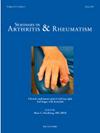估计莱姆病后自身免疫性炎症性关节炎的发病率
IF 4.4
2区 医学
Q1 RHEUMATOLOGY
引用次数: 0
摘要
目的:先前的一系列病例描述了莱姆病(LD) 2年内发生新的自身免疫性炎症性关节炎(IA)的发展。本研究旨在利用行政索赔数据估计LD后IA的发生率。流感,一种通常与感染后IA无关的感染,被用于比较。方法采用2013年1月- 2024年5月约翰霍普金斯医疗系统行政索赔数据进行回顾性队列研究。使用国际疾病分类(ICD)代码确定患有LD和流感的患者,通过要求在ICD代码发布后30天内开具抗生素处方来进一步确定LD病例。使用2+ ICD编码识别类风湿关节炎、银屑病关节炎或脊椎关节炎的IA病例。感染组间比较酌情采用卡方检验和z检验。在控制年龄和性别的情况下,进行Logistic回归分析以估计莱姆病或流感诊断后两年内发生IA的几率。结果LD后IA的发生率明显高于流感(1.67% vs 0.45%, p <;0.0001), LD后一年内IA的发生率最高。回归分析显示,与流感相比,LD与IA的发生率增加相关(OR 3.76, 95% CI: 2.41-5.86, p <;0.001),在调整了年龄和性别后。结论LD感染后1年内IA的发生率高于一般人群。时间关联和发病率升高支持有必要进行前瞻性研究,以阐明LD感染和自身免疫之间的联系机制。本文章由计算机程序翻译,如有差异,请以英文原文为准。
Estimating the incidence of autoimmune inflammatory arthritis after Lyme disease
Objective
A previous case series described the development of new autoimmune, inflammatory arthritis (IA) developing within 2 years of Lyme disease (LD). This study aimed to estimate the incidence of IA following LD using administrative claims data. Influenza, an infection not typically associated with post-infectious IA, was used for comparison.
Methods
We conducted a retrospective cohort study using the Johns Hopkins Health System administrative claims data from 01/2013–05/2024. Patients with LD and influenza were identified using International Classification of Diseases (ICD) codes, with LD cases further defined by requiring an antibiotic prescription within 30 days of the ICD code. IA cases were identified using 2+ ICD codes for rheumatoid arthritis, psoriatic arthritis or spondyloarthritis. Comparisons between infection groups were conducted using chi-square tests and Z-tests as appropriate. Logistic regression analyses were conducted to estimate the odds of IA development within two years of Lyme or influenza diagnosis, controlling for age and sex.
Results
The incidence of IA was significantly higher following LD compared to influenza (1.67 % vs 0.45 %, p < 0.0001), with the highest incidence of IA occurring within the first year after LD. Regression analysis showed LD was associated with increased odds of IA compared to influenza (OR 3.76, 95 % CI: 2.41–5.86, p < 0.001) after adjusting for age and sex.
Conclusion
The incidence of IA was higher within a year of LD infection, higher than that expected in the general population. The temporal association and elevated incidence support the need for prospective studies to elucidate mechanisms linking infection and autoimmunity in LD.
求助全文
通过发布文献求助,成功后即可免费获取论文全文。
去求助
来源期刊
CiteScore
9.20
自引率
4.00%
发文量
176
审稿时长
46 days
期刊介绍:
Seminars in Arthritis and Rheumatism provides access to the highest-quality clinical, therapeutic and translational research about arthritis, rheumatology and musculoskeletal disorders that affect the joints and connective tissue. Each bimonthly issue includes articles giving you the latest diagnostic criteria, consensus statements, systematic reviews and meta-analyses as well as clinical and translational research studies. Read this journal for the latest groundbreaking research and to gain insights from scientists and clinicians on the management and treatment of musculoskeletal and autoimmune rheumatologic diseases. The journal is of interest to rheumatologists, orthopedic surgeons, internal medicine physicians, immunologists and specialists in bone and mineral metabolism.

 求助内容:
求助内容: 应助结果提醒方式:
应助结果提醒方式:


